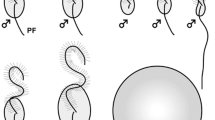In marine green algae, isogamous or slightly anisogamous species are taxonomically widespread. They produce positively phototactic gametes in both sexes. We developed a new numerical simulator of gamete behavior using C++ and pseudo-parallelization methods to elucidate potential advantages of phototaxis. Input parameters were set based on experimental data. Each gamete swimming in a virtual rectangular test tank was tracked and the distances between the centers of nearby male and female were measured at each step to detect collisions. Our results shed light on the roles of gamete behavior and the mechanisms of the evolution of anisogamy and more derived forms of sexual dimorphism. We demonstrated that not only gametes with positive phototaxis were favored over those without, particularly in shallow water. This was because they could search for potential mates on the 2-D water surface rather than randomly in three dimensions. Also, phototactic behavior clarified the difference between isogamy and slight anisogamy. Isogamous species produced more zygotes than slightly anisogamous ones only under the phototactic conditions. Our results suggested that ‘sperm limitation’ might be easily resolved particularly in the slightly anisogamous species. Some more markedly anisogamous species produce the smaller male gametes without any phototactic devices and the larger positively phototactic female gametes. In such species, female gametes attract their partners using a sexual pheromone. This pheromonal attraction system might have played a key role in the evolution of anisogamy, because it could enable markedly anisogamous species achieve 2-D search efficiencies on the water surface. The mating systems appear to be tightly tuned o the environmental conditions of their habitats.
Similar content being viewed by others
References
Bray D. (1992) Cell swimming. In: Cell Movements (ed. Bray D.), pp. 3–16. Garland Publishing, New York.
Chapman V. J., Edomonds A. S., Dromgoole F. I. (1964) Halicystis in: New Zealand. Nature 202: 414.
Cox P. A., Cromar S., Jarvis T. (1991) Underwater pollination, three-dimensional search, and pollenmorphology: predictions from a supercomputer analysis. In: Pollen and Spores (eds S. Blackmore & S. H. Barnes), pp. 363–375. Clarendon Press, Oxford.
Cox P. A. & Sethian J. A. (1985) Gamete motion, search, and the evolution of anisogamy, oogamy, and chemotaxis. American Naturalist 125: 74–101.
Dawes C. J. (1998) Marine Botany. John Wiley, New York.
Dusenbury D. B. (1992) Sensory Ecology. Freeman, New York.
Dusenbury D. B. (2000) Selection for high gamete encounter rates explains the success of male and female mating types. Journal of Theoretical Biology 202: 1–10.
Le Méhauté B. (1976) An Introduction to Hydrodynamics and Water Waves. Springer, Berlin.
Levitan D. R. (1996) Effects of gamete traits on fertilization in the sea and the evolution of sexual dimorphism. Nature 382: 153–155.
Matsuda H. & Abrams P. A. (1999) Why are equally sized gametes so rare? The instability of isogamy and the cost of anisogamy. Evolutionary Ecology Research 1: 769–784.
Maynard Smith J. (1978) The Evolution of Sex. Cambridge University Press, Cambridge.
Melkonian M. (1982) Structural and evolutionary aspects of the flagellar apparatus in green algae and land plants. Taxon 31: 255–265.
Miyaji K. (1985) Taxonomic studies on the genus Spongomorpha. PhD Thesis, Hokkaido University, Sapporo (in Japanese with English summary).
Parker G. A., Baker R. R., Smith V. G. F. (1972) The origin and evolution of gamete dimorphism and the male-female phenomenon. Journal of Theoretical Biology 36: 529–553.
Randerson J. P. & Hurst L. D. (2001) The uncertain evolution of the sexes. Trends in Ecology and Evolution 16: 571–579.
Shuster S. M. & Wade M. J. (2003) Mating Systems and Strategies. Princeton University Press, Princeton.
Stratmann J., Paputsoglu G., Oertel W. (1996) Differentiation of Ulva mutabilis (Chlorophyta) gametangia and gamete release are controlled by extracellular inhibitors. Journal of Phycology 32: 1009–1021.
Tatewaki M. (1969) Culture studies on the life histories of some species of the genus Monostroma. Scientific Papers of the Institute of Algological Research, Faculty of Science, Hokkaido University, 6: 1–56.
Togashi T. (1998) Reproductive strategies, mating behaviors and the evolution of anisogamy in marine green algae. PhD Thesis, Hokkaido University, Sapporo.
Togashi T. & Cox P. A. (2001) Tidal-linked synchrony of gamete release in the marine green alga, Monostroma angicava Kjellman. Journal of Experimental Marine Biology and Ecology 264: 117–131.
Togashi T. & Cox P. A. (2004) Phototaxis and the evolution of isogamy and ‘slight anisogamy’ in marine green algae: insights from laboratory observations and numerical experiments. Botanical Journal of the Linnean Society 144: 321–327.
Togashi T., Miyazaki T., Cox P. A. (2002) Sexual reproduction in marine green algae: gametic behavior and the evolution of anisogamy. In: Proceedings of Two Symposia on Ecology Ad Evolution in VIII INTECOL, August 2002, Seoul, Korea, (eds J. Yoshimura, N. Nakagiri & W. M. Shields), pp. 70–79. Sangaku Publisher, Ohtsu.
Togashi T., Motomura T., Ichimura T. (1997) Production of anisogametes and gamete motility dimorphism in Monostroma angicava. Sexual Plant Reproduction 10: 261–268.
Togashi T., Motomura T., Ichimura T. (1998) Gamete dimorphism in Bryopsis plumosa: phototaxis, gamete motility and pheromonal attraction. Botanica Marina 41: 257–264.
Togashi T., Motomura T., Ichimura T., Cox P. A. (1999) Gametic behavior in a marine green alga, Monostroma angicava: an effect of phototaxis on mating efficiency. Sexual Plant Reproduction 12: 158–163.
Wilson W. (2000) Simulating Ecological and Evolutionary Systems in C. Cambridge University Press, Cambridge.
Author information
Authors and Affiliations
Corresponding author
About this article
Cite this article
TOGASHI, T., BARTELT, J. & COX, P. Simulation of gamete behaviors and the evolution of anisogamy: reproductive strategies of marine green algae. Ecol Res 19, 563–569 (2004). https://doi.org/10.1111/j.1440-1703.2004.00672.x
Received:
Accepted:
Issue Date:
DOI: https://doi.org/10.1111/j.1440-1703.2004.00672.x



